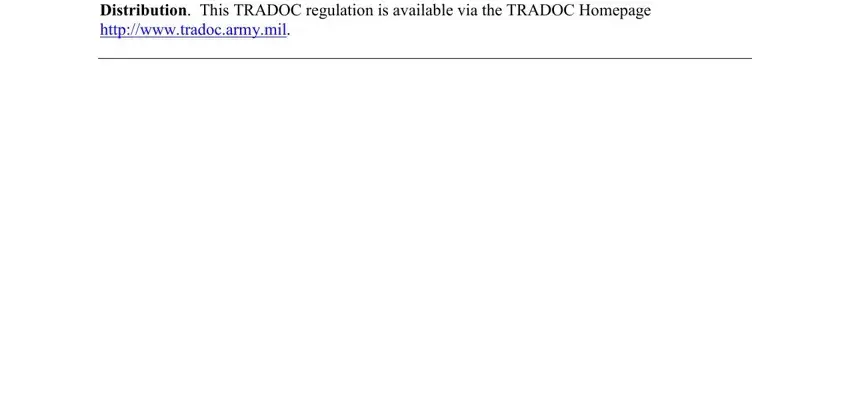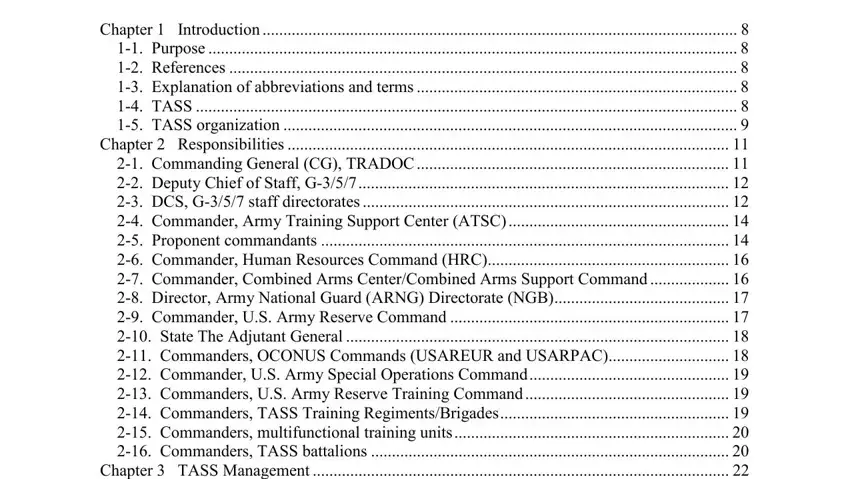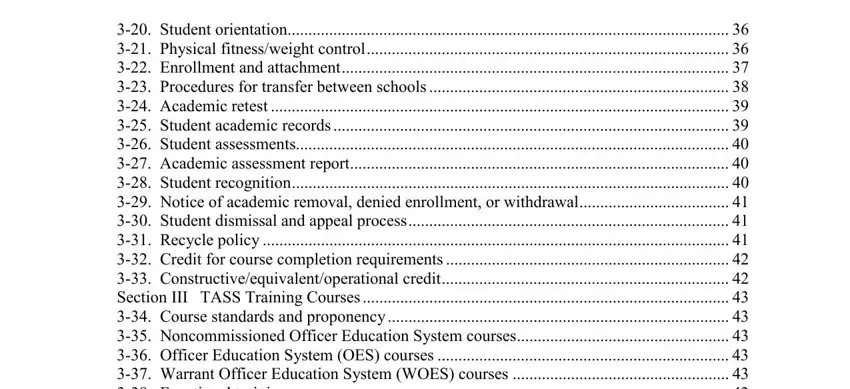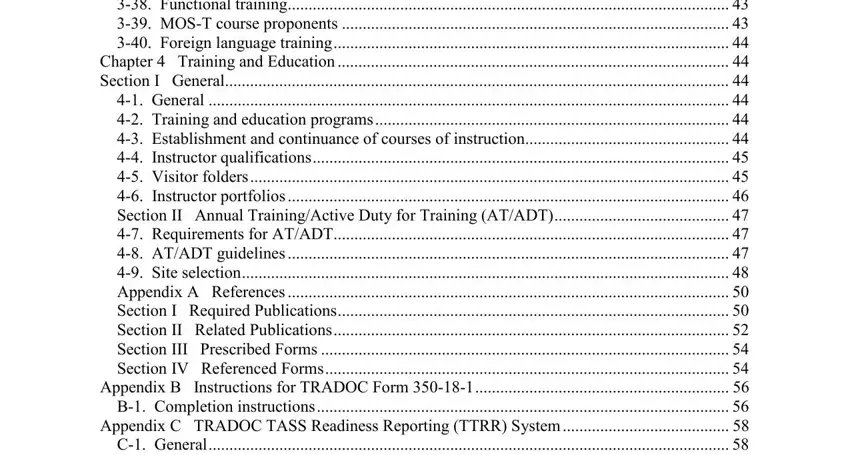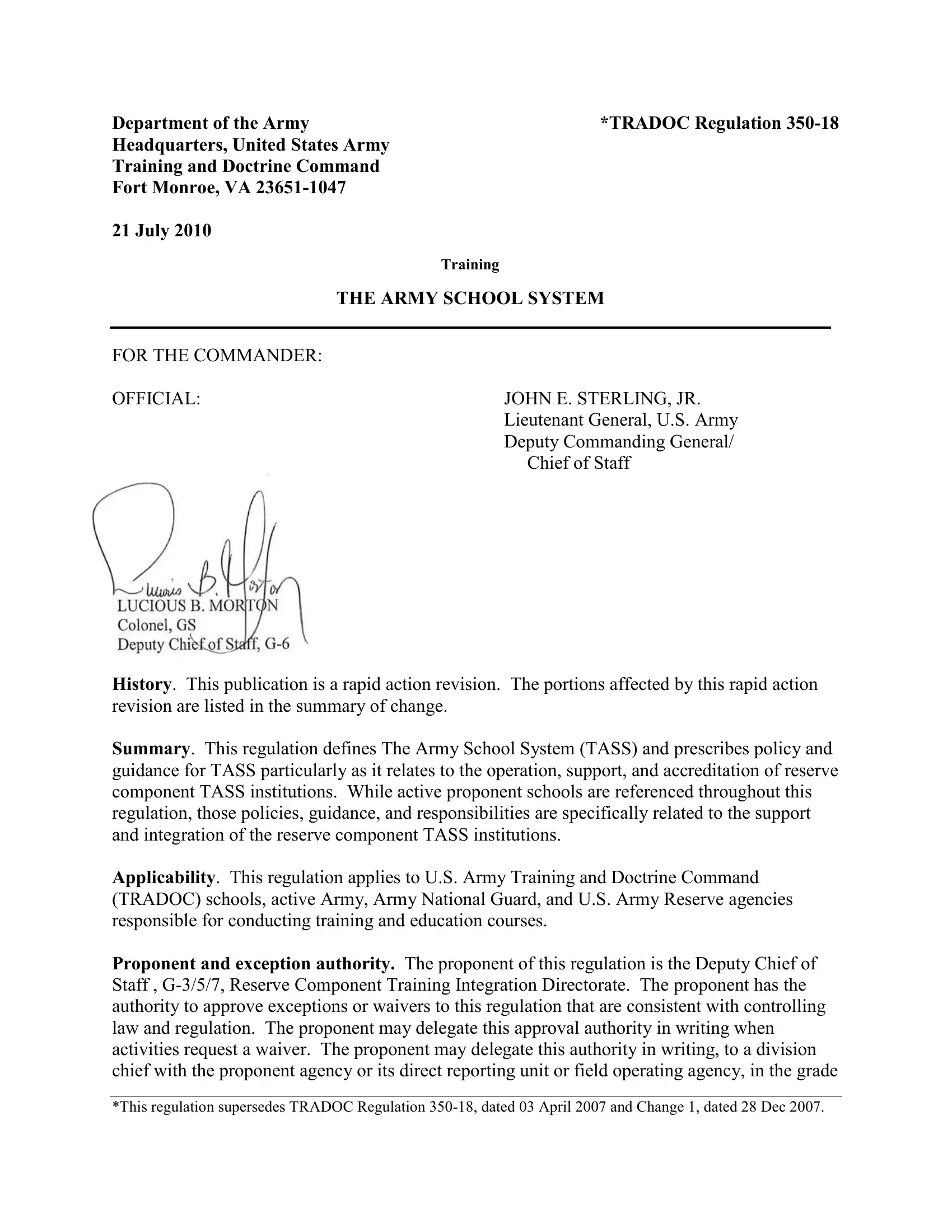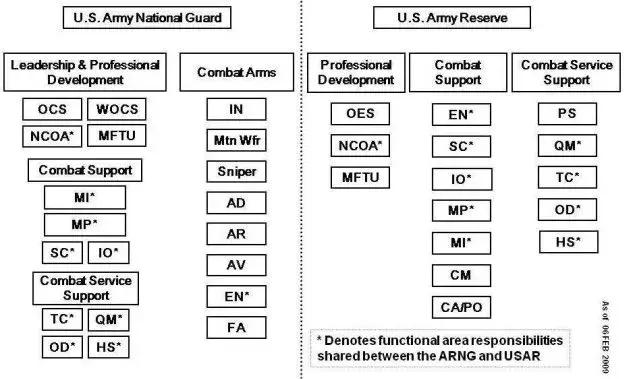
Department of the Army |
*TRADOC Regulation 350-18 |
Headquarters, United States Army |
|
Training and Doctrine Command |
|
Fort Monroe, VA 23651-1047 |
|
21 July 2010 |
|
|
Training |
THE ARMY SCHOOL SYSTEM
FOR THE COMMANDER: |
|
OFFICIAL: |
JOHN E. STERLING, JR. |
|
Lieutenant General, U.S. Army |
|
Deputy Commanding General/ |
|
Chief of Staff |
History. This publication is a rapid action revision. The portions affected by this rapid action revision are listed in the summary of change.
Summary. This regulation defines The Army School System (TASS) and prescribes policy and guidance for TASS particularly as it relates to the operation, support, and accreditation of reserve component TASS institutions. While active proponent schools are referenced throughout this regulation, those policies, guidance, and responsibilities are specifically related to the support and integration of the reserve component TASS institutions.
Applicability. This regulation applies to U.S. Army Training and Doctrine Command (TRADOC) schools, active Army, Army National Guard, and U.S. Army Reserve agencies responsible for conducting training and education courses.
Proponent and exception authority. The proponent of this regulation is the Deputy Chief of Staff , G-3/5/7, Reserve Component Training Integration Directorate. The proponent has the authority to approve exceptions or waivers to this regulation that are consistent with controlling law and regulation. The proponent may delegate this approval authority in writing when activities request a waiver. The proponent may delegate this authority in writing, to a division chief with the proponent agency or its direct reporting unit or field operating agency, in the grade
*This regulation supersedes TRADOC Regulation 350-18, dated 03 April 2007 and Change 1, dated 28 Dec 2007.
TRADOC Reg 350-18
of colonel or the civilian equivalent. Activities may request a waiver to this regulation by providing justification that includes a full analysis of the expected benefits and must include formal review by the activity’s senior legal officer. All waiver requests will be endorsed by the commander or senior leader of the requesting activity and forwarded through their higher headquarters to the policy proponent.
Management control process. This regulation is subject to the requirements of Army Regulation (AR) 11-2 Managers’ Internal Control Program.
Supplementation. Supplementation of this regulation and establishment of command and local forms are prohibited without prior approval from the Reserve Component Training Integration Directorate (ATTG-TRR-R), 3 Bernard Road, Bldg 105, Fort Monroe, VA 23651.
Suggested improvements. The proponent of this regulation is the Reserve Component Training Integration Directorate. Forward comments and suggested improvements on DA Form 2028 (Recommended Changes to Publications and Blank Forms) through channels to Reserve Component Training Integration Directorate (ATTG-TRR), 3 Bernard Road, Bldg 105, Fort Monroe, VA 23651-1057. Suggested improvements may also be submitted using DA Form 1045 (Army Ideas for Excellence Program (AIEP) Proposal).
Distribution. This TRADOC regulation is available via the TRADOC Homepage http://www.tradoc.army.mil.
2
TRADOC Reg 350-18
Summary of Change
TRADOC Regulation 350-18
The Army School System
This rapid action revision, dated 21 July 2010–
oChanges the summary to focus on The Army School System policy and guidance specifically to how it relates to the operation, support, and accreditation of reserve component TASS institutions.
oRemoves references to Deputy Chief of Staff for Operations and Training and replaces it with Deputy Chief of Staff G-3/5/7.
oUpdates names and responsibilities of Deputy Chief of Staff, G-3/5/7 directorates based on conversion to G-staff and subsequent reorganization.
oRealigns Army National Guard and U.S. Army Reserve responsibilities in accordance with current organization and mission.
oRemoves Office of the Chief, Army Reserve and Regional Readiness Commands references.
oRemoves Forces Command and Continental United States Army references.
oRemoves all references to Title XI support to The Army School System, including general support provisions for TRADOC Title XI Soldiers (Chapter 2) and use of Title XI personnel in support of The Army School System (Chapter 3).
oEliminates Section III Mobilization Training and other related references.
oMakes U.S. Army Training and Doctrine Command Form 350-18-12-2-E, (paper form) obsolete only for reserve component schools; replaced by Army Training Requirements and Resources System automated pre-execution checklist (para 3-22 a).
oChanges the Training Coordination Council Workshop process (para 3-15).
oUpdates references, terminology, and organization titles throughout the publication.
oRemoves reference to specific ranks for appeal authorities in the student dismissal and appeals process (para 3-30).
oChanges the amount of time that training proponents have to respond to course-related waiver requests from 45 days to 30 days from the date of the request. (para 2-5 b (4))
3
TRADOC Reg 350-18
TRADOC Regulation 350-18 rapid action revision, dated 3 April 2007–
oRemoves references to Deputy Chief of Staff Education and replaces with Reserve Component Training Integration Directorate (para 2-3).
oAddresses the relationship of Reserve Component Training Integration Directorate and U.S. Army Training and Doctrine Command Quality Assurance Program (para 2-3).
oRemoves references to The Army School System Integration Elements (Chapter 2).
oSpecifies the role of Title XI in reserve component accreditation (Chapter 3).
oRemoves Accreditation policy and procedures covered by Headquarters, U.S. Army Training and Doctrine Command Quality Assurance Office (Chapter 3).
oAdds appeal process for reserve component students not covered in Army Training and Leadership Development, Army Regulation 350-1 (para 3-32).
oRemoves chapters 5 and 6 incorporating content not governed by component command regulations.
oUpdates references to regulations and field manuals (app A).
oAdds Appendix C, Quarterly The Army School System Readiness Report from Reserve Component Commands to Headquarters, U.S. Army Training and Doctrine Command, Reserve Component Training Integration Directorate (app C).
4
|
|
TRADOC Reg 350-18 |
Contents |
|
Page |
Chapter 1 |
Introduction |
8 |
1-1. |
Purpose |
8 |
1-2. |
References |
8 |
1-3. |
Explanation of abbreviations and terms |
8 |
1-4. TASS |
8 |
1-5. |
TASS organization |
9 |
Chapter 2 |
Responsibilities |
11 |
2-1. Commanding General (CG), TRADOC |
11 |
2-2. |
Deputy Chief of Staff, G-3/5/7 |
12 |
2-3. |
DCS, G-3/5/7 staff directorates |
12 |
2-4. Commander, Army Training Support Center (ATSC) |
14 |
2-5. Proponent commandants |
14 |
2-6. Commander, Human Resources Command (HRC) |
16 |
2-7. Commander, Combined Arms Center/Combined Arms Support Command |
16 |
2-8. Director, Army National Guard (ARNG) Directorate (NGB) |
17 |
2-9. Commander, U.S. Army Reserve Command |
17 |
2-10. |
State The Adjutant General |
18 |
2-11. Commanders, OCONUS Commands (USAREUR and USARPAC) |
18 |
2-12. Commander, U.S. Army Special Operations Command |
19 |
2-13. Commanders, U.S. Army Reserve Training Command |
19 |
2-14. Commanders, TASS Training Regiments/Brigades |
19 |
2-15. |
Commanders, multifunctional training units |
20 |
2-16. Commanders, TASS battalions |
20 |
Chapter 3 |
TASS Management |
22 |
Section I |
Procedures |
22 |
3-1. |
General |
22 |
3-2. |
Institution standing operating procedures |
22 |
3-3. |
Soldier safety and force protection |
23 |
3-4. Risk assessment and management |
23 |
3-5. |
Conduct of institutional training and education |
23 |
3-6. |
Military occupational specialty-transition (reclassification) |
24 |
3-7. The Army Training System Course |
25 |
3-8. |
Instructor qualification and certification |
25 |
3-9. |
Instructor grade and experience requirements |
25 |
3-10. |
Instructional products and training aids requisitioning |
26 |
3-11. |
Reproduction and distribution |
30 |
3-12. |
Test control procedures |
30 |
3-13. |
Attendance register |
30 |
3-14. |
Maintenance of training support records |
31 |
3-15. |
Training coordination council workshop |
31 |
3-16. Army Training Requirements and Resources System |
32 |
3-17. |
Training and education resources |
32 |
Section II |
Student Administration |
36 |
3-18. |
Selection |
36 |
3-19. |
Orders |
36 |
|
|
|
5 |
|
|
|
|
|
TRADOC Reg 350-18 |
|
3-20. |
Student orientation |
36 |
3-21. |
Physical fitness/weight control |
36 |
3-22. |
Enrollment and attachment |
37 |
3-23. |
Procedures for transfer between schools |
38 |
3-24. |
Academic retest |
39 |
3-25. |
Student academic records |
39 |
3-26. |
Student assessments |
40 |
3-27. |
Academic assessment report |
40 |
3-28. |
Student recognition |
40 |
3-29. |
Notice of academic removal, denied enrollment, or withdrawal |
41 |
3-30. |
Student dismissal and appeal process |
41 |
3-31. |
Recycle policy |
41 |
3-32. |
Credit for course completion requirements |
42 |
3-33. |
Constructive/equivalent/operational credit |
42 |
Section III TASS Training Courses |
43 |
3-34. |
Course standards and proponency |
43 |
3-35. Noncommissioned Officer Education System courses |
43 |
3-36. |
Officer Education System (OES) courses |
43 |
3-37. Warrant Officer Education System (WOES) courses |
43 |
3-38. |
Functional training |
43 |
3-39. MOS-T course proponents |
43 |
3-40. |
Foreign language training |
44 |
Chapter 4 |
Training and Education |
44 |
Section I |
General |
44 |
4-1. |
General |
44 |
4-2. |
Training and education programs |
44 |
4-3. |
Establishment and continuance of courses of instruction |
44 |
4-4. |
Instructor qualifications |
45 |
4-5. |
Visitor folders |
45 |
4-6. |
Instructor portfolios |
46 |
Section II Annual Training/Active Duty for Training (AT/ADT) |
47 |
4-7. Requirements for AT/ADT |
47 |
4-8. AT/ADT guidelines |
47 |
4-9. |
Site selection |
48 |
Appendix A References |
50 |
Section I |
Required Publications |
50 |
Section II |
Related Publications |
52 |
Section III |
Prescribed Forms |
54 |
Section IV |
Referenced Forms |
54 |
Appendix B Instructions for TRADOC Form 350-18-1 |
56 |
B-1. |
Completion instructions |
56 |
Appendix C TRADOC TASS Readiness Reporting (TTRR) System |
58 |
C-1. General |
58 |
C-2. Guidance |
58 |
6
|
|
TRADOC Reg 350-18 |
Glossary |
60 |
Section I |
Abbreviations |
60 |
Section II |
Terms |
63 |
List of figures |
|
Figure 1-1. RC TASS functional alignment |
10 |
Figure 3-13. TRADOC Form 270-R-E sample |
31 |
Figure B-1. |
TRADOC Form 350-18-1 sample |
56 |
7
TRADOC Reg 350-18
Chapter 1
Introduction
1-1. Purpose
This regulation establishes policy, guidance, and procedures for operation, administration, training and education support, and conduct of The Army School System (TASS), as defined in this regulation (see para 1-4). Forward exceptions to operational procedures for overseas commands (U.S. Army, Pacific (USARPAC) and U.S. Army, Europe (USAREUR)) through the United States Army Reserve Command (USARC) to U.S. Army Training and Doctrine Command (TRADOC), Deputy Chief of Staff (DCS) G-3/5/7, Reserve Component Training Integration Directorate (RCTID).
1-2. References
Required and related publications and prescribed and referenced forms are listed in appendix A.
1-3. Explanation of abbreviations and terms
Abbreviations and terms used in this regulation are explained in the glossary.
1-4. TASS
a.TASS is a composite system made up of Army National Guard (ARNG), U.S. Army Reserve (USAR), and active Army (AA) schools. TASS conducts initial military training (IMT), reclassification training, officer, warrant officer (WO), noncommissioned officer (NCO) and Department of the Army (DA) civilian professional development training, functional training, and education. Training and education are accomplished through standard resident, active duty for training (ADT), inactive duty training (IDT), and distributed/distance learning (DL) courses.
b.See Army Regulation (AR) 350-1, paragraph 1-29 for DA policy regarding TASS.
c.Reserve component (RC) TASS units are functionally aligned and linked to appropriate proponents. The Army proponents include TRADOC proponent schools and:
(1)U.S. Army John F. Kennedy Special Warfare Center and School (USAJFKSWCS).
(2)The Judge Advocate General’s Legal Center and School (TJAGLCS).
(3)U.S. Army Medical Department Center and School (AMEDDCS).
(4)U.S. Army Management Staff College (AMSC).
(5)U.S. Army Force Management School (AFMS).
(6)Department of the Army Inspector General (DAIG).
(7)Civilian Personnel Operations Center (CPOC).
8
TRADOC Reg 350-18
(8)U.S. Military Academy (USMA).
(9)U.S. Army Corps of Engineers (USACE).
(10)U.S. Army Materiel Command (AMC) Schools.
(11)U.S. Army Criminal Investigation Command (USACIDC).
d.The AA proponents serve as a link to the RC schools to ensure equivalency. This link ensures quality assurance (QA), instructor certification, The Army Training System (TATS) courseware availability, use of the Analysis, Design, Development, Implementation, and Evaluation (ADDIE) curriculum design method, and a DL strategy. The TATS courseware ensures that all Army Soldiers, regardless of component, receive the same critical task instruction, regardless of which TASS institutions conduct the training or education.
e.TASS training and education missions are validated during the Structure Manning Decision Review (SMDR) process, reflected in the Army Program for Individual Training (ARPRINT), and documented in Army Training Requirements and Resources System (ATRRS). Training and education missions are fully resourced through a deliberate cross component (AA, ARNG, and USAR) affiliation program.
f.Some TASS institutions and units focus on education as the primary method of instructions while others may focus on training. Many TASS units use a combination of both methods of instructions through a variety of courses. For the purposes of this regulation, the term "training" may be used throughout as a generic term to also include policy and guidance that applies equally to educationally focused units, institutions, and courses. Learning objectives should be substituted for critical tasks where applicable.
1-5. TASS organization
a.DCS G-3/5/7. Paragraph 2-2 of this regulation delineates responsibilities for the DCS G- 3/5/7. This organization is located at Headquarters (HQ), TRADOC and staffed by AA, ARNG, and USAR personnel.
b.RCTID. Paragraph 2-3 of this regulation delineates duties for RCTID. This organization is located at HQ, TRADOC and staffed by AA, ARNG, and USAR personnel.
c.Proponents. TRADOC Regulation (TR) 350-70 and AR 350-1 prescribe policy for proponents.
d.States' The Adjutant General (TAG). Command responsibility for ARNG units is vested in the state and territorial governors who execute their responsibilities through TAGs. State TAGs provide command and control of the ARNG TASS activities within their state/territory.
e.USAR Training Command (TASS) provides command and control through the divisions of USAR TASS schools.
9
TRADOC Reg 350-18
f.TASS training regiments (REGTs)/brigades (BDEs): functional alignment is provided (see figure 1-1).
Figure 1-1. RC TASS functional alignment
(1)ARNG regional training institutions (RTIs) are subordinate to the TAGs and are responsible for their aligned ARNG TASS battalions (BN).
(2)USAR TASS BDEs are subordinate to the 80th Training Command (TASS) Divisions
with responsibility for aligned USAR TASS BN. USAR Noncommissioned Officer Education System (NCOES) and Officer Education System (OES) BNs are subordinate to the 84th Training Command.
g.Multifunctional training units (MFTU) are located outside the continental United States (OCONUS). These TASS training units present unique situations because of their lack of proximity to other training facilities. They offer officer and noncommissioned officer professional development courses and military occupational specialty – transition (MOS-T) to all components of the Army and must conduct most of this training and education on their own. Because of the broad mission, MFTUs are not directly affiliated with any one proponent school, but are subject to the same accreditation standards as other TASS institutions. MFTUs follow the operational procedures and requirements of this regulation.
(1)USAR MFTUs are located in Germany, Hawaii, and Puerto Rico and are under the command and control of U.S. Army Reserve Command (USARC).
10
